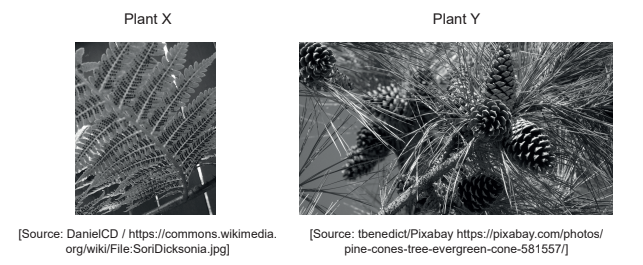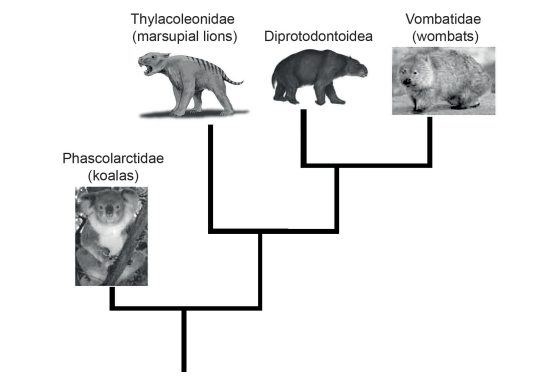Question
(a) The images show parts of plants belonging to two different phyla.

X: . . . . . . . . . . . . . . . . . . . . . . . . . . . . . . . . . . . . . . . . . . . . . . . . . . . . . . . . . . . . . . . . . . . . .
Y: . . . . . . . . . . . . . . . . . . . . . . . . . . . . . . . . . . . . . . . . . . . . . . . . . . . . . . . . . . . . . . . . . . . . .
State the phylum of plant X and of plant Y.
b Explain one cause of mutation.
c. Outline the types of evidence that can be used to place a species in a particular clade.
d. The cladogram includes four marsupial (non-placental mammal) families.

Deduce the family that is most closely related to the Diprotodontoidea.
Answer/Explanation
Ans:
a)
X: Filicinophyta
Y: Coniferophyta/Conifera/Gymnosperms
b) 
c)
a. clade is a group of organisms that have evolved from a common ancestor
b. identify the base sequences of a gene
c. identify amino acid sequence of a protein
d. comparing homologous structures
e. the fewer the differences, the closer they diverged in time from a common ancestor Accept vice versa.
d)
Question
(a) Outline four types of membrane transport, including their use of energy.
(b) Draw the structure of a dipeptide.
(c) Explain the action of enzymes in digestion and the different roles of at least two named enzymes that are produced in the pancreas.
Answer/Explanation
Ans:
a)
a. simple diffusion is passive movement of molecules/ions along a concentration gradient
b. facilitated diffusion is passive movement of molecules/ions along a concentration gradient through a protein channel «without use of energy»
c. osmosis is the passage of water through a membrane from lower solute concentration to higher
d. active transport is movement of molecules/ions against the concentration gradient «through membrane pumps» with the use of ATP/energy
e. endocytosis is the infolding of membrane/formation of vesicles to bring molecules into cell with use of energy
OR
exocytosis is the infolding of membrane/formation of vesicles to release molecules from cell with use of energy
f. chemiosmosis occurs when protons diffuse through ATP synthase «in membrane» to produce ATP
b)
a. two amino acids, one with $NH_2/NH^{3+}$ end and one with $COOH/COO^–$ end
b. peptide bond between C=0 and N—H correctly drawn
c. «chiral» C with H and R group on each amino acid
d. peptide bond labelled/clearly indicated between C terminal of one amino acid and N terminal of the second amino acid
c)
a. enzymes catalyse/speed up chemical reactions/lower the energy needed
b. have specific active sites to which specific substrates bind
c. enzyme catalysis involves molecular motion and the collision of substrates with the active site
d. enzymes break macromolecules into monomers/smaller molecules in digestion
e. smaller molecules/monomers more readily absorbed
f. <<pancreas>> secretes enzymes into the «lumen of» small intestine
g. the small intestine has an alkaline pH
h. enzymes have maximum action at specific pHs
OR
enzymes can be denatured at other pHs
i. amylase breaks down starch into sugars/disaccharides
j. lipase breaks lipids/triglycerides into monoglycerides/fatty acids and glycerol
k. endopeptidase/protease breaks «peptide» bonds in proteins/polypeptides
